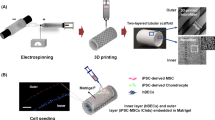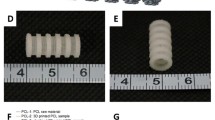Abstract
Long-segment defects remain a major problem in clinical treatment of tubular tissue reconstruction. The design of tubular scaffold with desired structure and functional properties suitable for tubular tissue regeneration remains a great challenge in regenerative medicine. Here, we present a reliable method to rapidly fabricate tissue-engineered tubular scaffold with hierarchical structure via 4-axis printing system. The fabrication process can be adapted to various biomaterials including hydrogels, thermoplastic materials and thermosetting materials. Using polycaprolactone (PCL) as an example, we successfully fabricated the scaffolds with tunable tubular architecture, controllable mesh structure, radial elasticity, good flexibility, and luminal patency. As a preliminary demonstration of the applications of this technology, we prepared a hybrid tubular scaffold via the combination of the 4-axis printed elastic poly(glycerol sebacate) (PGS) bio-spring and electrospun gelatin nanofibers. The scaffolds seeded with chondrocytes formed tubular mature cartilage-like tissue both via in vitro culture and subcutaneous implantation in the nude mouse, which showed great potential for tracheal cartilage reconstruction.
摘要
管状组织大段缺损的重建是临床治疗上的一个难题. 如何设计并制备具有理想结构的功能管状支架用于管状组织修复仍然是再生医学中的一个主要挑战. 本研究采用4轴打印系统快速地制备了具有多级结构的管状组织工程支架, 该方法适用于多种生物材料, 如水凝胶、热塑性生物材料以及热固性生物材料. 以聚己内酯(PCL)为例, 我们成功制备了管状结构可调、类编织网格结构可控, 径向弹性、轴向柔性及管腔开放性良好的支架. 作为管状组织再生的初步应用, 我们利用4轴打印技术制备了聚癸二酸甘油酯(PGS)的热固性生物弹簧, 并与静电纺技术相结合制备了杂化的PGS/明胶纳米纤维管状支架. 该支架接种软骨细胞后在体外培养和裸鼠皮下植入均可形成成熟的管状软骨组织, 有望应用于气管软骨重建.
Similar content being viewed by others
References
Yu P, Clayman GL, Walsh GL. Long-term outcomes of microsurgical reconstruction for large tracheal defects. Cancer, 2011, 117: 802–808
Goh CSL, Joethy JV, Tan BK, et al. Large animal models for long-segment tracheal reconstruction: a systematic review. J Surg Res, 2018, 231: 140–153
Virk JS, Zhang H, Nouraei R, et al. Prosthetic reconstruction of the trachea: a historical perspective. World J Clin Cases, 2017, 5: 128–133
Gong W, Lei D, Li S, et al. Hybrid small-diameter vascular grafts: anti-expansion effect of electrospun poly ε-caprolactone on heparin-coated decellularized matrices. Biomaterials, 2016, 76: 359–370
Dikina AD, Alt DS, Herberg S, et al. A modular strategy to engineer complex tissues and organs. Adv Sci, 2018, 5: 1700402
Hussey GS, Keane TJ, Badylak SF. The extracellular matrix of the gastrointestinal tract: a regenerative medicine platform. Nat Rev Gastroenterol Hepatol, 2017, 14: 540–552
de Jonge PKJD, Simaioforidis V, Geutjes PJ, et al. Recent advances in ureteral tissue engineering. Curr Urol Rep, 2015, 16: 465
Del Gaudio C, Baiguera S, Ajalloueian F, et al. Are synthetic scaffolds suitable for the development of clinical tissue-engineered tubular organs? J Biomed Mater Res, 2014, 102: 2427–2447
Góra A, Pliszka D, Mukherjee S, et al. Tubular tissues and organs of human body—challenges in regenerative medicine. J Nanosci Nanotechnol, 2016, 16: 19–39
Versteegden LR, van Kampen KA, Janke HP, et al. Tubular collagen scaffolds with radial elasticity for hollow organ regeneration. Acta Biomater, 2017, 52: 1–8
Janke HP, Bohlin J, Lomme RMLM, et al. Bioinspired coupled helical coils for soft tissue engineering of tubular structures—improved mechanical behavior of tubular collagen type I templates. Acta Biomater, 2017, 59: 234–242
Kang H, Zhang K, Pan Q, et al. Remote control of intracellular calcium using upconversion nanotransducers regulates stem cell differentiation in vivo. Adv Funct Mater, 2018, 28: 1802642
Park JH, Hong JM, Ju YM, et al. A novel tissue-engineered trachea with a mechanical behavior similar to native trachea. Biomaterials, 2015, 62: 106–115
Park JH, Park JY, Nam IC, et al. A rational tissue engineering strategy based on three-dimensional (3D) printing for extensive circumferential tracheal reconstruction. Biomaterials, 2018, 185: 276–283
Wu W, Allen RA, Wang Y. Fast-degrading elastomer enables rapid remodeling of a cell-free synthetic graft into a neoartery. Nat Med, 2012, 18: 1148–1153
Huang X, Jiao T, Liu Q, et al. Hierarchical electrospun nanofibers treated by solvent vapor annealing as air filtration mat for high-efficiency PM2.5 capture. Sci China Mater, 2018, 62: 423–436
Lou L, Kong X, Zhu T, et al. Facile fabrication of interconnected-mesoporous T-Nb2O5 nanofibers as anodes for lithium-ion batteries. Sci China Mater, 2019, 62: 465–473
Lei D, Yang Y, Liu Z, et al. 3D printing of biomimetic vasculature for tissue regeneration. Mater Horiz, 2019, 6: 1197–1206
Robertson ID, Yourdkhani M, Centellas PJ, et al. Rapid energy-efficient manufacturing of polymers and composites via frontal polymerization. Nature, 2018, 557: 223–227
Gantenbein S, Masania K, Woigk W, et al. Three-dimensional printing of hierarchical liquid-crystal-polymer structures. Nature, 2018, 561: 226–230
Nune KC, Li S, Misra RDK. Advancements in three-dimensional titanium alloy mesh scaffolds fabricated by electron beam melting for biomedical devices: mechanical and biological aspects. Sci China Mater, 2018, 61: 455–474
Correa VL, Garza KM, Murr LE. Vascularization in interconnected 3D printed Ti-6Al-4V foams with hydrogel matrix for biomedical bone replacement implants. Sci China Mater, 2018, 61: 565–578
Kang HW, Lee SJ, Ko IK, et al. A 3D bioprinting system to produce human-scale tissue constructs with structural integrity. Nat Biotechnol, 2016, 34: 312–319
Gao F, Xu Z, Liang Q, et al. Direct 3D printing of high strength biohybrid gradient hydrogel scaffolds for efficient repair of osteochondral defect. Adv Funct Mater, 2018, 28: 1706644
Itoh M, Nakayama K, Noguchi R, et al. Scaffold-free tubular tissues created by a bio-3D printer undergo remodeling and endothelialization when implanted in rat aortae. PLoS ONE, 2015, 10: e0136681
Wang Y, Ameer GA, Sheppard BJ, et al. A tough biodegradable elastomer. Nat Biotechnol, 2002, 20: 602–606
Xu Y, Li D, Yin Z, et al. Tissue-engineered trachea regeneration using decellularized trachea matrix treated with laser micropore technique. Acta Biomater, 2017, 58: 113–121
Yan D, Zhou G, Zhou X, et al. The impact of low levels of collagen IX and pyridinoline on the mechanical properties of in vitro engineered cartilage. Biomaterials, 2009, 30: 814–821
Chen J, Yuan Z, Liu Y, et al. Improvement of in vitro three-dimensional cartilage regeneration by a novel hydrostatic pressure bioreactor. Stem Cell Transl Med, 2017, 6: 982–991
Mahdavi A, Ferreira L, Sundback C, et al. A biodegradable and biocompatible gecko-inspired tissue adhesive. Proc Natl Acad Sci USA, 2008, 105: 2307–2312
Ye X, Lu L, Kolewe ME, et al. Scalable units for building cardiac tissue. Adv Mater, 2014, 26: 7202–7208
Rai R, Tallawi M, Grigore A, et al. Synthesis, properties and biomedical applications of poly(glycerol sebacate) (PGS): a review. Prog Polymer Sci, 2012, 37: 1051–1078
Loh XJ, Abdul Karim A, Owh C. Poly(glycerol sebacate) biomaterial: synthesis and biomedical applications. J Mater Chem B, 2015, 3: 7641–7652
Yeh YC, Highley CB, Ouyang L, et al. 3D Printing of photocurable poly(glycerol sebacate) elastomers. Biofabrication, 2016, 8: 045004
Lei D, Yang Y, Liu Z, et al. A general strategy of 3D printing thermosets for diverse applications. Mater Horiz, 2019, 6: 394–404
Mo X, Li D, Ei-Hamshary HA, et al. Electrospun nanofibers for tissue engineering. J Fiber Bioeng Inform, 2013, 6: 225–235
Yang JM, Yang JH, Tsou SC, et al. Cell proliferation on PVA/sodium alginate and PVA/poly(γ-glutamic acid) electrospun fiber. Mater Sci Eng-C, 2016, 66: 170–177
Kojima K, Vacanti CA. Tissue engineering in the trachea. Anat Rec, 2014, 297: 44–50
Gong YY, Xue JX, Zhang WJ, et al. A sandwich model for engineering cartilage with acellular cartilage sheets and chondrocytes. Biomaterials, 2011, 32: 2265–2273
Tanaka H, Maeda K, Okita Y. Transplantation of the cryopreserved tracheal allograft in growing rabbits. J Pediatr Surg, 2003, 38: 1707–1711
Acknowledgements
This work was supported by the National Key Research and Development Program of China (2018YFB1105602 and 2017YFC1103900), the National Natural Science Foundation of China (21574019, 81320108010, 81571823 and 81871502), the Natural Science Foundation of Shanghai (18ZR1401900), the Fundamental Research Funds for the Central Universities, DHU Distinguished Young Professor Program (LZA2019001), the Science and Technology Commission of Shanghai (17DZ2260100 and 15DZ1941600), the Program for Shanghai Outstanding Medical Academic Leader, and the Program of Shanghai Technology Research Leader.
Author information
Authors and Affiliations
Contributions
Author contributions Lei D designed and performed all experiments, analyzed the data and prepared the manuscript. Xu Y performed the chondrocytes culture and trachea reconstruction. Luo B and Shen A contributed to 3D printing. Guo Y performed SEM characterization and statistic analysis. Liu Z and Wang S performed PGS polymer synthesis. Wang D and Yang H performed the manufacture of receivers. Xuan H contributed to electrospinning. Zhang Y contributed to mechanical testing. He C and Qing FL contributed to the discussion and analysis of the experimental result. Zhou G discussed the concept and contributed to the writing of the manuscript. You Z supervised the whole work and wrote the manuscript.
Corresponding authors
Ethics declarations
Conflict of interest The authors declare no conflict of interest.
Additional information
Dong Lei is a PhD student at the State Key Laboratory for Modification of Chemical Fibers and Polymer Materials at Donghua University. From 2013 to now, he has been conducting his master and doctoral research at Donghua University. His current research involves biomaterials, 3D printing and tissue regeneration.
Yong Xu received his MCs degree from the Department of Thoracic Surgery, Shanghai Pulmonary Hospital, Tongji University School of Medicine in 2018. Now he is continuing to study for a PhD degree in the Department of Thoracic Surgery, Shanghai Pulmonary Hospital, Tongji University School of Medicine. His research interests focus on cartilage regenerative biomaterials and functional tracheal reconstruction.
Guangdong Zhou is a professor of Medical College of Shanghai Jiao Tong University, Executive Vice-Director of National Center for Tissue Engineering Research, Former Secretary-General and Executive Director of Tissue Engineering and Regenerative Medicine Branch of Chinese Society of Biomedical Engineering. His research interests focus on the functional cartilage regeneration and clinical application transformation, construction of cartilage in vitro and precise regulation of its three-dimensional morphology (auricle, trachea, etc.), and repair of various cartilage defects in large animals.
Zhengwei You is a professor and the chair of Department of Composite Materials at Donghua University. He received his BSc degree from Shanghai Jiao Tong University and PhD degree from Shanghai Institute of Organic Chemistry. He conducted his postdoctoral research at Georgia Institute of Technology and University of Pittsburgh. Prior to joining Donghua University, he was an innovation manager in Bayer Material Science. His current research involves smart polymers, biomaterials, 3D printing, and stretchable electronics.
Electronic supplementary material
Rights and permissions
About this article
Cite this article
Lei, D., Luo, B., Guo, Y. et al. 4-Axis printing microfibrous tubular scaffold and tracheal cartilage application. Sci. China Mater. 62, 1910–1920 (2019). https://doi.org/10.1007/s40843-019-9498-5
Received:
Accepted:
Published:
Issue Date:
DOI: https://doi.org/10.1007/s40843-019-9498-5




